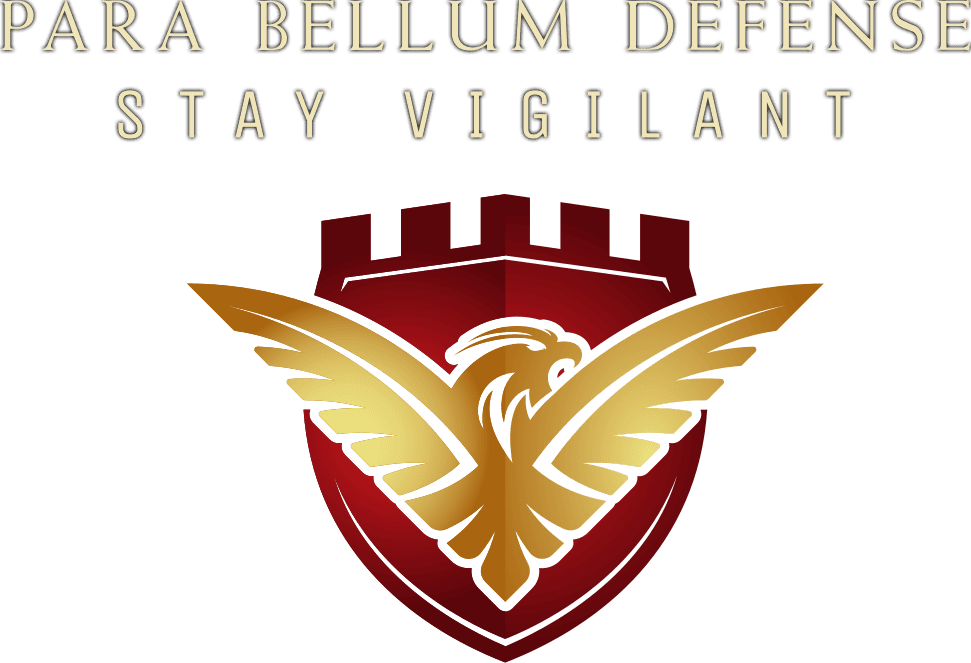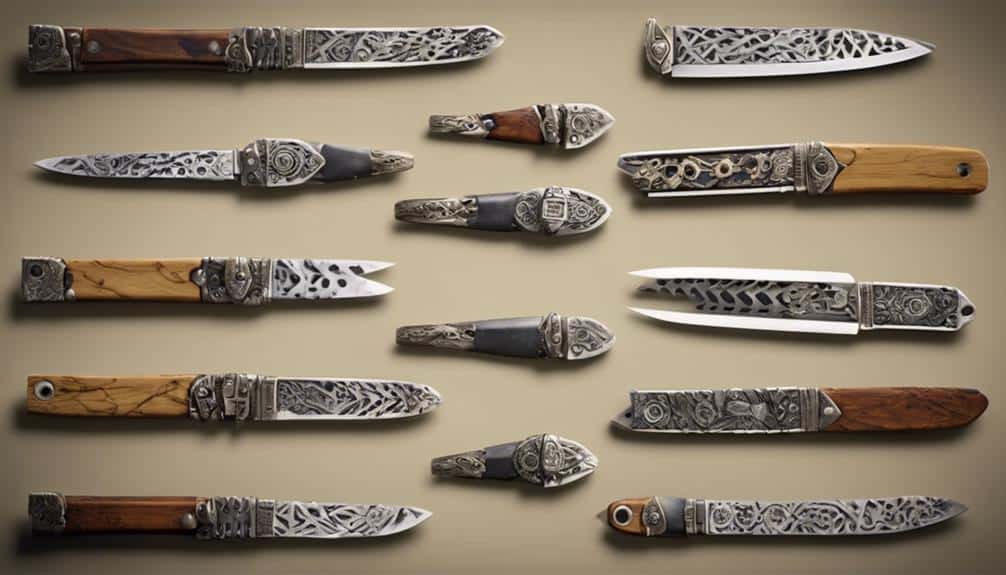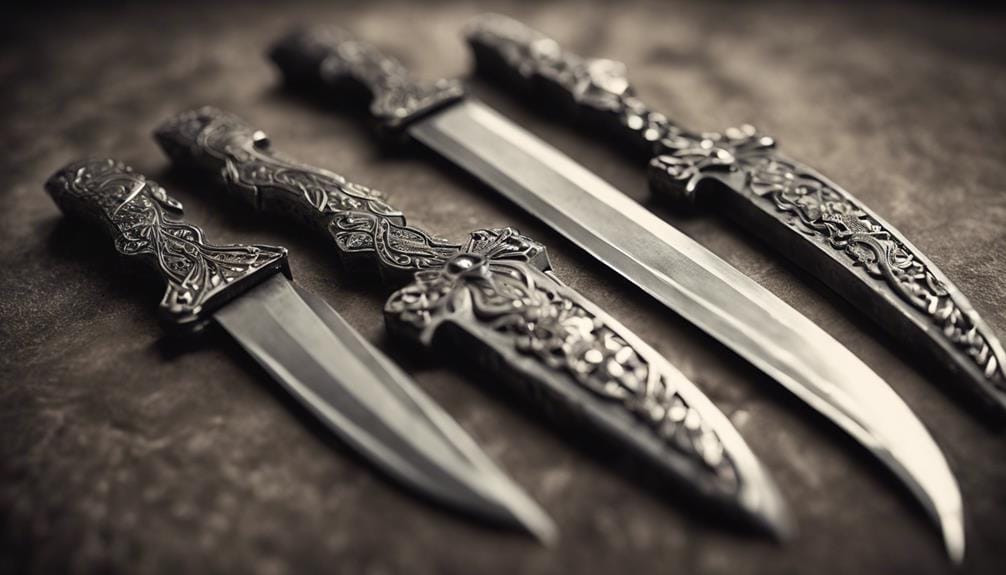You might think there’s a big difference between a
balisong and a
butterfly knife, but guess what, there isn’t! They’re actually the same knife, just called differently. The term “balisong” comes from the Philippines, where these nifty blades have a
rich history and cultural significance. Meanwhile, “butterfly knife” is what they’re often called in the West, highlighting their cool
flipping action. Imagine this: a knife that’s like a ninja toy, with two handles that swivel around to hide or reveal the blade. Intrigued? There’s plenty more fascinating lore and details to uncover about these iconic blades.
Historical Roots
The historical roots of the
balisong, often referred to internationally as the
butterfly knife, are deeply embedded in
Filipino culture. When you think of a balisong, imagine a tool that’s not just a weapon but a piece of history from the Philippines. The term “balisong” comes from the barangay Balisong in Batangas, where these knives are traditionally crafted.
Dating back to around 800 CE, the balisong has a rich
historical origin. Picture ancient artisans in the Philippines, skillfully shaping these knives, which later saw mass production in the early 1900s. The name “balisong” translates to “broken horn,” referring to its traditional handles made from animal horn. Pretty cool, right?
The
cultural significance of the balisong goes beyond its physical form. It’s deeply tied to
Filipino martial arts, where it was developed as a
practical weapon. Imagine Filipino warriors, flipping these knives with precision and grace. The butterfly knife, as it’s known globally, might be popular, but the balisong holds a special place in Filipino hearts. It’s more than just a knife; it’s a symbol of heritage, skill, and
cultural pride.
Naming Conventions
Understanding the historical roots of the balisong sets the stage for exploring its naming conventions. When you hear “balisong knives,” you’re diving into a rich Filipino tradition, especially from the Batangas province. The term “balisong” translates to “broken horn,” a nod to the traditional animal horn handles. It’s not just a name; it’s a piece of cultural history.
On the flip side (pun intended), “butterfly knife” originated in Western contexts, particularly in the United States during the mid-20th century. This name highlights the knife’s aesthetic appeal and its mesmerizing flipping capabilities. You can almost see it: the two handles rotating around the tang, concealing the blade with a satisfying click.
Here’s where it gets interesting:
- Cultural Significance: “Balisong” points directly to its Filipino roots, embodying a sense of pride and tradition.
- Global Appeal: “Butterfly knife” speaks to a broader audience, focusing on the knife’s cool factor and flipping fun.
- Materials and Craftsmanship: The term “balisong” hints at the traditional materials and intricate craftsmanship from the Philippines.
Construction and Design
Diving into the construction and design of a balisong, you’ll find a fascinating blend of tradition and innovation. The
balisong knife, or
butterfly knife, is a marvel of engineering with its two handles that rotate around the tang, concealing the blade when closed. Whether you’re a collector or just curious, you’ll appreciate the craftsmanship behind these knives.
Balisongs are typically built using either
sandwich construction or
channel construction. Sandwich construction allows for tighter pivot pin adjustments, making it easier to tweak for smoothness. Channel construction, on the other hand, is stronger, crafted from a single piece, giving it extra durability.
The handles can be made from various materials, from traditional carved carabao and deer horn to modern aluminum and G10, which add durability. The
blade styles, like tanto and drop point, offer versatility, whether you’re slicing, dicing, or just admiring the aesthetics.
A key feature you’ll notice is the
pivot joint, which lets the handles rotate smoothly.
Tang pins prevent the blade from dulling when closed, ensuring longevity. And don’t forget, butterfly knives are
legal in many places, so you can enjoy them without worry.
Key Components
Exploring the key components of a balisong reveals the intricate details that make these knives both functional and fascinating. When you delve into the anatomy of a butterfly knife, such as the
Butterfly Knife Stainless Steel, you’ll discover how each part plays an essential role in its operation.
First off, the
tang is where the magic happens. This is the part that connects the blade to the handles, allowing them to rotate smoothly. Thanks to the
pivot joint, the handles swing around the tang with ease, making those flashy tricks possible.
Let’s break it down:
- Latch: This nifty feature keeps your balisong securely closed when not in use, preventing accidental openings.
- Blade: The star of the show, the blade is concealed within the handles when closed, ready to spring into action.
- Handles: There are two of these, and they serve different purposes. The bite handle closes on the sharp edge of the blade, while the safe handle closes on the non-sharpened edge, making it safer to handle.
Lastly, don’t forget about the
tang pin(s) and
kicker. The tang pins prevent the blade from dulling and limit handle impact, while the kicker stops the blade edge from hitting the handle’s inside. Together, these components create a pocket-sized marvel that’s both a tool and a piece of art.
Legal Considerations
When you’re thinking about owning a balisong, you’ve got to keep in mind that laws differ wildly from state to state. Some places treat them like dangerous switchblades, while others have no problem with them at all. Before you get one, make sure you know your
local rules—getting caught could mean fines or even
jail time!
State-Specific Regulations
State-specific regulations on balisongs, also known as butterfly knives, can greatly impact your ability to own or carry these knives legally. Knife laws can be confusing and vary widely depending on where you live. For instance, in California, you can legally own a butterfly knife if the blade is 2 inches or less, but anything larger is a no-go in public. Meanwhile, New Jersey treats balisongs as illegal weapons, making ownership a bit of a gray area. In contrast, Michigan considers them legal folding knives, giving you more freedom there.
New York decriminalized butterfly knife possession in 2019, but local laws about concealed carrying still apply, so be careful. Tennessee and Virginia don’t have any restrictions on carrying balisongs, whether open or concealed, but you should always check local regulations to be sure.
Here are a few key points to remember about state and local knife laws:
- California: Legal if blade is 2 inches or less.
- New Jersey: Ambiguous legality often considered illegal.
- Tennessee and Virginia: No restrictions on carrying.
Understanding the legality and ownership rules in your state is vital. Don’t assume what’s fine in one place is okay everywhere!
Concealed Carry Restrictions
Maneuvering concealed carry restrictions for balisongs can be a legal minefield, given the diverse regulations across different jurisdictions. In the United States, for instance, the rules are all over the map. California says no way to carrying balisongs with blades longer than 2 inches, while Virginia’s cool with both concealed and open carry. It’s like traversing a maze!
In the Philippines, things get even trickier. You need identification or permits to carry a balisong, thanks to its unfortunate link with crime. So always have your papers in order if you’re there.
And let’s not forget other countries. Australia, Germany, and the UK? They’ve got strict bans. Meanwhile, Finland and France allow it, but only if you can prove you need it for something useful or get special authorization.
To make life easier, here’s a quick table to give you a snapshot of concealed carry restrictions:
| Country |
Restrictions |
| United States |
Varies by state and sometimes by city |
| Philippines |
Requires identification or permits |
| Australia |
Strictly prohibited |
| Germany |
Strictly prohibited |
| UK |
Strictly prohibited |
Penalties and Enforcement**
Maneuvering the penalties and enforcement surrounding balisongs can feel like an intimidating task, but understanding the legal landscape is essential. You might think owning a balisong is a breeze, but knife laws can be as tricky as the flips themselves. Similar to self-defense keychains, penalties for illegal possession vary widely. In some places, you might just get a slap on the wrist with a fine, while in others, you could face serious jail time. Imagine getting caught in a strict city like Boston, where local regulations are even tougher than Massachusetts state laws!
Law enforcement agencies are always on the lookout, conducting searches and seizures. If you’re caught with a balisong where it’s banned, it’s not just a bad day—it’s a potential misdemeanor or worse if it’s linked to a crime. That’s why responsible ownership is key. Knowing your local regulations isn’t just smart; it’s necessary. Ignorance won’t save you in court. Additionally, being aware of alternatives like
self-defense keychain options can provide you with practical tools for personal safety.
Here’s a quick guide to stay safe:
- Check Local Regulations: Know the rules where you live and travel.
- Avoid Public Spaces: If your state restricts balisongs, don’t carry them around.
- Stay Informed: Laws change, so keep up to date to avoid hefty penalties.
Cultural Impact
You’re probably wondering how a knife could mean so much to different cultures, right? In the Philippines, the
balisong isn’t just a tool—it’s a
symbol of pride and Filipino craftsmanship, especially from regions like Batangas. Meanwhile, in the West, butterfly knives became iconic in the ’90s thanks to martial arts films, sparking a surge in enthusiasts who love showcasing their
flipping tricks online.
Symbolism in Filipino Culture
The balisong, often known as the butterfly knife, holds deep cultural significance in the Philippines, symbolizing the intricate skill and artistry of traditional Filipino martial arts like Arnis. In Filipino culture, the balisong isn’t just a tool; it’s a symbol of resilience and resourcefulness. When you see a balisong, you’re looking at a piece of craftsmanship that local artisans, especially from Batangas, have honed over centuries.
Consider these key points:
- Craftsmanship: The balisong’s unique flipping techniques and intricate designs showcase the exceptional skill of Filipino artisans.
- Resilience: This knife is a representation of the Filipino spirit, reflecting how locals can use limited resources to create something remarkable.
- Cultural Heritage: Owning a balisong connects you to the rich history and pride of Filipino culture, celebrating both utility and artistry.
In Filipino communities, the balisong is more than a knife; it’s a reminder of the Philippines’ rich history, blending utility and artistry. Its popularity in martial arts and street culture has even made it a global symbol, promoting appreciation for Filipino ingenuity and cultural heritage. So, when you flip a balisong, you’re not just showcasing a skill—you’re celebrating a legacy.
Western Media Influence
Western media has played a significant role in shaping the
global perception of the
balisong, often referred to as the
butterfly knife. You’ve probably seen these knives in action-packed movies from the ’90s, where they were depicted as
symbols of skill, danger, and intrigue. These portrayals contributed to their
cultural perception as tools of agility and combat proficiency, especially among
martial arts enthusiasts and collectors.
In video games, especially those with martial arts themes, butterfly knives are often featured as sleek, deadly weapons, further cementing their association with high-octane action. The rise of
social media has taken this fascination to new heights. Now, you can find countless videos of people performing mesmerizing balisong tricks, flipping and twirling these knives with incredible precision. This online community celebrates the artistry involved, making the balisong a must-have for anyone interested in functional utility and skillful display.
Interestingly, this
Western media influence contrasts sharply with the balisong’s traditional use in the Philippines, where it’s valued for its
practical utility and historical significance. So, next time you see a butterfly knife in a film or game, remember—it’s more than just a cool prop; it’s a cultural icon.
Martial Arts Integration
In Filipino martial arts, particularly Arnis, balisongs hold a revered place for both their offensive and defensive capabilities. You’ll find these knives as integral tools in many training sessions, such as the
Butterfly Knife Black, which is designed for a comfortable grip and well-balanced flipping. Practitioners use them to showcase quick deployment and manipulation skills, impressing everyone with their dexterity. Imagine flipping a knife with such grace and precision that it almost becomes a dance—this is a true reflection of martial skill and artistic expression.
The cultural significance of balisongs in Filipino martial arts can’t be overstated. They symbolize heritage and proficiency, making them more than just weapons. They’re a statement. Here are three key points to examine:
- Quick Deployment: Balisongs are designed for rapid use, ensuring you’re always ready.
- Tricks: The flipping techniques are not just for show; they hone your agility and control.
- Cultural Significance: Using a balisong connects you to a rich tradition and history.
In martial arts films and demonstrations, you’ll often see balisongs adding flair and excitement. Competitions featuring balisong tricks blend martial skill with entertainment, making these knives a beloved part of the martial arts community. So, if you’re diving into Filipino martial arts, embracing the balisong is a must!
Frequently Asked Questions
Are Balisong and Butterfly Knife the Same?
Yes, they’re the same. Balisong history stems from the Philippines, while butterfly knife mechanics are popular in the U.S. Master balisong tricks, explore butterfly knife types, and guarantee proper balisong maintenance for safe knife collecting.
You need to check butterfly knife legality in your area. Balisong regulations vary widely, affecting knife ownership laws. For self-defense knives, collectors’ market, or knife training, understanding local laws is essential to avoid legal consequences.
What Are the Fake Butterfly Knives Called?
You might think they’re harmless, but fake butterfly knives, often called “replica butterfly” or “training knives,” pose safety concerns. These collector’s items use cheap blade materials, lack proper balance for knife tricks, and have potential legal implications.
What Are the Advantages of a Balisong?
You’ll appreciate the balisong’s versatility: it’s great for practical use, performance tricks, and martial arts. Thanks to its rich history, various styles, and easy maintenance, you can safely train, collect, and enjoy this fascinating tool.







